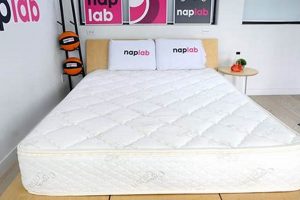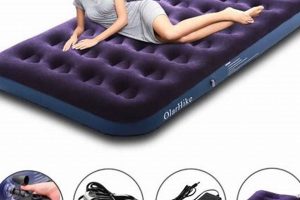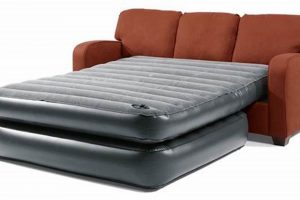A portable sleep system combines insulation and cushioning for temporary lodging needs. This integrated setup typically consists of an inflatable air chamber for support and a thermally protective outer layer to retain body heat. These systems are commonly used for camping, travel, and accommodating overnight guests.
Such configurations offer convenience and enhanced comfort compared to traditional ground pads or sleeping directly on the floor. The elevated air mattress provides spinal alignment and pressure relief, while the insulated covering minimizes heat loss, crucial for maintaining a comfortable body temperature in varied environmental conditions. Historically, simpler versions have been utilized by explorers and military personnel, evolving into increasingly sophisticated designs for recreational use.
The subsequent sections will delve into the specific types of these integrated systems available, factors to consider when selecting one, proper usage and maintenance techniques, and a comparative analysis of leading products on the market.
Considerations for Selecting an Integrated Sleep System
Choosing the optimal integrated sleep system requires careful evaluation of several key factors. Prioritizing these aspects ensures comfort, durability, and suitability for intended use.
Tip 1: Thermal Resistance (R-Value): Evaluate the insulation capacity of the outer covering. A higher R-value indicates greater insulation and is critical for cold-weather applications.
Tip 2: Mattress Material and Construction: Assess the air mattress’s material for puncture resistance and weight-bearing capacity. Internal baffling structure influences support and comfort levels.
Tip 3: Size and Weight: Consider the packed size and overall weight, especially if portability is paramount. Backpacking requires lighter, more compact options compared to car camping.
Tip 4: Ease of Inflation/Deflation: Examine the inflation mechanism. Built-in pumps, manual pumps, or compatibility with external pumps affect setup convenience and efficiency.
Tip 5: Durability and Water Resistance: Investigate the denier of the outer shell fabric and the presence of water-resistant coatings. These factors determine longevity and protection against moisture.
Tip 6: Storage and Maintenance: Understand the recommended storage procedures to prevent damage. Inspect seams and valves regularly to ensure proper functionality.
Adhering to these guidelines maximizes the lifespan and performance of the integrated sleep system, guaranteeing a comfortable and restorative rest experience.
The concluding section will summarize key advantages and offer final recommendations for prospective buyers.
1. Portability
Portability is a critical design parameter for integrated sleep systems. The inherent benefit of combining insulation and an inflatable mattress is to reduce the bulk and weight associated with separate components. A primary cause of compromised portability arises from the materials selected. Heavier fabrics, denser insulation, and thicker mattress materials increase overall weight and packed size, directly hindering ease of transport. For example, a system designed for base camp use might prioritize durability and insulation over minimal weight, rendering it unsuitable for backpacking.
The importance of portability manifests differently depending on the intended application. For backpacking, where every ounce counts, lightweight systems with compact packed dimensions are essential. Alternatively, for car camping or guest accommodations, portability is less critical, allowing for larger, more comfortable designs. Integrated compression straps and carrying cases further enhance portability by minimizing packed volume and facilitating secure handling. Consider, for instance, a system utilizing down insulation and lightweight nylon; while offering superior compressibility and reduced weight, it may require more meticulous care than a system with synthetic insulation and a more robust outer shell.
Ultimately, the significance of portability in integrated sleep systems is context-dependent. Manufacturers must balance comfort, durability, and thermal performance with the need for a transportable package. Understanding the relationship between design choices and resulting portability is crucial for selecting a system that aligns with specific usage scenarios. Failure to prioritize this aspect can lead to discomfort and impracticality in the field, negating the advantages of an integrated design.
2. Insulation Rating
The insulation rating is a critical specification for integrated sleep systems, directly impacting user comfort and thermal regulation in varying environmental conditions. Effective insulation mitigates heat loss, crucial for maintaining a safe and comfortable body temperature during sleep. The following aspects delineate the key factors influencing insulation performance.
- R-Value Measurement
The R-value quantifies a material’s resistance to heat flow. A higher R-value indicates greater insulation capacity. In integrated sleep systems, R-values typically range from 1 to 5+, with higher values recommended for colder climates. For example, a system with an R-value of 4 would be suitable for temperatures around freezing, while a system with an R-value of 2 might be adequate for warmer summer conditions.
- Insulation Material Type
The type of insulation material significantly affects thermal performance. Down insulation offers excellent warmth-to-weight ratio and compressibility but loses its insulating properties when wet. Synthetic insulation, such as polyester fibers, retains some warmth even when damp and is generally more affordable. Hybrid systems combine down and synthetic materials to balance performance characteristics. For instance, a down-filled system might provide superior warmth for its weight compared to a solely synthetic alternative, but requires more diligent care to avoid moisture exposure.
- Construction Techniques
The construction method used to integrate insulation impacts its overall effectiveness. Baffles, which create compartments for the insulation, prevent cold spots and ensure even distribution. Stitch-through construction, while simpler, can compress the insulation and reduce its thermal resistance. Box-wall construction creates separate chambers, maximizing loft and minimizing cold spots. As an illustration, a system with a baffled construction will typically provide more consistent warmth across its surface than a system with simple stitch-through quilting.
- Effect of Mattress Inflation
The degree of mattress inflation can indirectly influence the insulation rating. Over-inflation can compress the insulation, reducing its loft and diminishing its thermal performance. Conversely, under-inflation can compromise support and comfort, potentially leading to cold spots. Maintaining proper mattress inflation, according to the manufacturer’s recommendations, optimizes both comfort and insulation efficiency. Consider a scenario where an over-inflated mattress causes the insulation to compress; the resulting reduction in loft would effectively lower the system’s R-value.
Ultimately, the insulation rating of an integrated sleep system is a composite measure influenced by multiple factors. Selecting a system with an appropriate R-value, considering the insulation material and construction, and maintaining proper mattress inflation are crucial steps in ensuring adequate thermal protection. These considerations directly impact the system’s ability to provide a comfortable and safe sleep environment, particularly in challenging outdoor conditions.
3. Mattress Support
Mattress support within an integrated sleeping system directly impacts user comfort, spinal alignment, and overall sleep quality. The design and construction of the inflatable mattress component significantly contribute to the system’s ability to provide adequate support across diverse body weights and sleeping positions.
- Internal Baffling Design
The internal structure of the air mattress dictates how weight is distributed and how the mattress conforms to the body. Baffling systems, such as horizontal, vertical, or convoluted designs, influence the firmness and stability of the sleeping surface. For example, a system with vertical baffles may offer greater stability and prevent side-to-side swaying compared to a system with simple horizontal baffles. This internal architecture dictates how the air chambers respond to pressure, directly influencing comfort and weight distribution.
- Material Thickness and Durability
The gauge and type of material used in the air mattress construction influence its ability to withstand pressure and maintain shape over time. Thicker, more durable materials, such as reinforced PVC or TPU, offer increased puncture resistance and weight-bearing capacity. A thinner material may be more susceptible to leaks and deformation, compromising support. Consider, for instance, a system constructed from a high-denier nylon fabric coated with TPU; this would offer greater resistance to abrasion and puncture compared to a system made of thinner, less durable PVC.
- Inflation Pressure Management
The ability to adjust and maintain proper inflation pressure is crucial for optimizing mattress support. Over-inflation can create an overly firm and uncomfortable surface, while under-inflation can lead to sagging and inadequate support. Systems with adjustable valves or integrated pumps allow users to fine-tune the pressure to their individual preferences. As an example, a system equipped with a micro-adjustment valve allows for precise pressure regulation, catering to varied user weights and preferred sleeping positions, ultimately impacting the quality of support and comfort.
- Weight Distribution and Load Capacity
The design and materials used determine the maximum weight the system can safely support. Exceeding the recommended weight capacity can damage the mattress and compromise its structural integrity. Systems designed for single users typically have lower weight capacities than those intended for couples. It is therefore crucial to select a system rated to accommodate the user’s weight, accounting for any additional gear or accessories placed on the mattress. For example, if the weight capacity is 250 pounds, and users weight 260 pounds, the support is compromised.
These factors collectively define the level of mattress support provided by an integrated sleeping system. The interplay between internal baffling, material durability, inflation management, and weight capacity determines the comfort, stability, and long-term performance of the mattress, directly influencing the user’s sleep experience. Careful consideration of these aspects is essential when selecting a system that meets individual needs and provides adequate support for restful sleep.
4. Inflation Method
The inflation method is a fundamental aspect of integrated sleep systems, directly impacting convenience, setup time, and overall user experience. Selecting a suitable inflation mechanism requires considering factors such as portability, power source availability, and desired inflation speed.
- Integrated Pumps
Integrated pumps, whether manual or electric, offer self-sufficiency by eliminating the need for external devices. Manual integrated pumps typically utilize a foot or hand-operated mechanism to inflate the mattress. Electric integrated pumps require a power source, such as batteries or a DC adapter. The convenience of an integrated pump is balanced against potential increases in weight and bulk. For example, a system with a built-in foot pump is self-contained, but it may require several minutes of manual effort to fully inflate, a consideration for users with limited physical stamina.
- External Pumps
External pumps, including battery-powered, AC-powered, or manual bellows-style pumps, provide flexibility in inflation options. Battery-powered pumps offer portability, while AC-powered pumps require access to an electrical outlet. Manual bellows pumps are lightweight and reliable but demand physical exertion. For instance, a user might opt for a compact, battery-powered pump for backpacking trips to minimize effort, while a car camper could choose a more powerful AC-powered pump for rapid inflation.
- Valve Compatibility
The type of valve used on the air mattress dictates compatibility with different inflation methods. Common valve types include Boston valves, pin valves, and one-way valves. Boston valves offer a wide opening for rapid inflation and deflation. Pin valves require a specialized adapter for inflation. One-way valves prevent air from escaping during inflation. As an illustration, a system with a Boston valve can be easily inflated with a variety of pumps and even by mouth in emergency situations, whereas a pin valve requires a specific nozzle attachment.
- Mouth Inflation
Although less common, mouth inflation remains a viable option in the absence of a pump. This method requires direct blowing into the valve, which can be time-consuming and potentially introduce moisture into the mattress. Mouth inflation is primarily reserved for emergency situations where other inflation methods are unavailable. For example, should a pump fail during a backcountry trip, mouth inflation can provide a temporary solution to inflate the mattress and maintain some level of comfort.
In summary, the selection of an appropriate inflation method for an integrated sleep system is a multifaceted decision. Consideration must be given to factors such as portability requirements, power source availability, valve compatibility, and user preferences. A well-chosen inflation method ensures efficient and convenient setup, enhancing the overall user experience.
5. Material Durability
Material durability is paramount in determining the longevity and performance of an integrated sleep system. The capacity of its constituent components to withstand environmental stressors and prolonged use dictates its overall reliability. The selection of appropriate materials directly influences the system’s resistance to abrasion, puncture, and degradation, ultimately affecting its lifespan and suitability for diverse applications.
- Outer Shell Fabric Strength
The outer shell fabric bears the brunt of exposure to abrasive surfaces and environmental elements. Fabric strength, often measured in denier (D), indicates the yarn’s weight per unit length. Higher denier fabrics offer greater resistance to tearing and abrasion. For instance, a 75D polyester fabric will exhibit superior durability compared to a 50D fabric. The implications for an integrated sleep system are clear: a robust outer shell fabric translates to increased resistance against punctures from ground debris and general wear during storage and transport.
- Mattress Material Puncture Resistance
The air mattress material must resist puncture from sharp objects and withstand repeated inflation and deflation cycles. Materials such as TPU (thermoplastic polyurethane) and reinforced PVC offer enhanced puncture resistance and elasticity compared to thinner, less robust options. A mattress constructed from TPU, for example, can withstand greater pressure and resist damage from minor abrasions, significantly extending the system’s operational life. The absence of sufficient puncture resistance results in air leaks and the subsequent loss of support and insulation.
- Seam Integrity and Construction
The integrity of the seams directly impacts the system’s ability to retain air and maintain its structural form. Reinforced stitching and durable seam tapes prevent air leakage and minimize the risk of seam failure under stress. Improperly constructed seams represent a point of weakness, prone to separation under pressure or during repetitive folding and unfolding. A well-constructed system employs robust seams that can withstand the stresses of inflation, deflation, and movement during sleep.
- Zipper and Closure Robustness
Zippers and closures, often used to attach the sleeping bag component to the air mattress or to seal the system for storage, must withstand frequent use without failure. Durable zippers, constructed from high-quality materials such as nylon or metal, and reinforced stitching around the zipper track ensure smooth operation and prevent separation. A flimsy zipper can quickly become a point of failure, rendering the system difficult to use and compromising its insulation properties. A robust zipper is essential for maintaining the system’s functionality and ease of use over its lifespan.
The material durability of an integrated sleep system represents a crucial determinant of its long-term value and performance. Prioritizing systems constructed from high-quality, durable materials ensures resistance to damage, prolonged lifespan, and consistent performance across various environmental conditions. Neglecting this aspect can result in premature failure and compromised functionality, negating the intended benefits of an integrated design.
6. Weight Capacity
Weight capacity represents a critical specification for integrated sleeping systems, directly influencing the product’s suitability and safety for intended users. Exceeding the stated weight limit can compromise the system’s structural integrity, leading to discomfort, damage, or potential failure. Understanding the factors influencing weight capacity and its relationship to the overall design is essential for informed decision-making.
- Mattress Material and Construction
The type and thickness of the mattress material, along with its internal construction, significantly contribute to its weight-bearing capabilities. Higher-denier fabrics, reinforced seams, and robust baffling systems enhance the mattress’s ability to distribute weight evenly and withstand pressure. For instance, a system utilizing heavy-duty PVC with welded seams will typically exhibit a higher weight capacity than one constructed from thinner, less durable materials. The internal baffling design, whether vertical or horizontal, also plays a crucial role in distributing weight and preventing localized stress concentrations.
- Frame and Support Structure (if applicable)
Some integrated systems incorporate a frame or additional support structures to enhance stability and increase weight capacity. These frames, often constructed from lightweight aluminum or steel, provide a rigid foundation that distributes weight more effectively. The presence of a frame allows the system to support heavier loads without compromising the mattress’s integrity. For example, a cot-style integrated system with a steel frame will typically offer a significantly higher weight capacity compared to a frameless design.
- Inflation Pressure and Distribution
The level of inflation pressure directly affects the mattress’s ability to support weight. Over-inflation can place undue stress on the material and seams, potentially leading to failure. Under-inflation, conversely, can result in inadequate support and sagging. Proper inflation pressure, as specified by the manufacturer, ensures optimal weight distribution and support. The design of the inflation valve and pump also influences the user’s ability to accurately control and maintain the correct pressure levels. For example, precise valves, such as those used on some high-end models, increase durability and product life compared to cheaper valves.
- Intended Use and User Profile
The intended use of the integrated sleeping system and the profile of the user directly influence the required weight capacity. Systems designed for backpacking or lightweight camping typically prioritize portability and may have lower weight limits. Conversely, systems intended for car camping or guest accommodations often prioritize comfort and durability, allowing for higher weight capacities. It is crucial to select a system that is rated to accommodate the user’s weight, plus any additional gear or accessories that may be placed on the mattress, to ensure safe and reliable performance.
Weight capacity is not merely a numerical specification; it represents a critical design parameter that reflects the system’s overall structural integrity and suitability for its intended application. Selecting an integrated sleeping system with an adequate weight capacity is essential for ensuring user safety, maximizing product lifespan, and achieving a comfortable and restful sleep experience.
7. Ease of Cleaning
Ease of cleaning directly impacts the long-term usability and hygiene of an integrated sleep system. These systems, often used in outdoor environments, are susceptible to dirt, moisture, and potential mildew growth. The construction and materials employed dictate the effort required for effective cleaning, subsequently affecting the user’s willingness to maintain the system properly. For example, a system with a water-resistant outer shell and a removable, machine-washable inner liner will be significantly easier to clean than a system with non-removable components and water-absorbent materials. Neglecting cleaning protocols can lead to odor buildup, material degradation, and a reduced lifespan of the product.
The design features contributing to ease of cleaning include removable and washable liners, water-resistant or waterproof outer materials, and smooth, easily accessible surfaces. The presence of zippers or other fasteners that allow for the separation of the sleeping bag component from the air mattress greatly simplifies the cleaning process. For example, systems utilizing durable, wipeable materials on the air mattress surface allow for quick cleaning of spills or dirt accumulation. Conversely, systems with intricate stitching patterns or absorbent fabrics require more intensive cleaning efforts, potentially involving specialized cleaning agents and prolonged drying times. The practical implication is that a user is more likely to consistently clean and maintain a system that is designed for ease of cleaning, leading to improved hygiene and extended product lifespan.
In conclusion, the correlation between ease of cleaning and the longevity and hygienic performance of an integrated sleep system is significant. Design choices that prioritize cleanability, such as removable liners and water-resistant materials, directly contribute to a system’s overall value. Failure to consider ease of cleaning can result in a product that is difficult to maintain, leading to premature degradation and reduced user satisfaction. Selecting a system with thoughtful cleaning features ensures both convenience and long-term performance.
Frequently Asked Questions
This section addresses common inquiries and concerns regarding integrated sleep systems, providing factual and objective information.
Question 1: What is the typical lifespan of an integrated sleep system?
The lifespan varies based on construction quality, materials, and usage frequency. High-quality systems, properly maintained, can last for several years with regular use.
Question 2: How is the warmth rating determined for these systems?
Warmth ratings are typically assessed using R-values, which quantify the system’s resistance to heat flow. Higher R-values indicate greater insulation capabilities.
Question 3: Can the air mattress be replaced independently if damaged?
Replacement depends on the system’s design. Some systems allow for independent mattress replacement, while others require replacing the entire unit.
Question 4: Are integrated sleep systems suitable for all weather conditions?
Suitability depends on the system’s insulation rating and construction. Systems with higher R-values and waterproof materials are better suited for inclement weather.
Question 5: What is the recommended storage method to prevent damage?
Systems should be stored clean and dry, preferably uncompressed, in a cool, dark environment to prevent material degradation.
Question 6: How is the weight capacity of an integrated sleep system determined?
Weight capacity is based on the mattress material, construction, and frame (if present). Exceeding the limit can compromise the system’s structural integrity.
Understanding these fundamental aspects facilitates informed decision-making when considering an integrated sleep system.
The subsequent article will delve into market comparisons and specific product recommendations.
Concluding Remarks
This exploration of integrated sleep systems, known colloquially as the “sleeping bag blow up mattress,” has illuminated the multifaceted considerations involved in their selection and utilization. The preceding sections have underscored the importance of evaluating factors such as insulation rating, mattress support, inflation method, material durability, weight capacity, and ease of cleaning. These elements collectively determine the system’s performance, lifespan, and suitability for diverse environments.
Prospective users should carefully weigh their specific needs and prioritize system attributes accordingly. Furthermore, adherence to recommended usage and maintenance practices is crucial for maximizing the longevity and efficacy of these integrated solutions. The future of these systems likely involves advancements in material science, improved insulation technologies, and enhanced ergonomic designs, furthering their utility in both recreational and emergency preparedness contexts.







